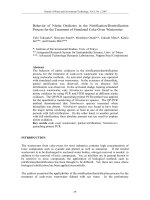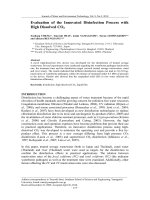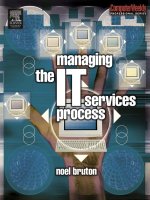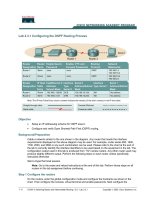the money supply process
Bạn đang xem bản rút gọn của tài liệu. Xem và tải ngay bản đầy đủ của tài liệu tại đây (316.85 KB, 32 trang )
Copyright 2011 Pearson
Canada Inc.
16-
1
Chapter 16
The Money Supply Process
Copyright 2011 Pearson
Canada Inc.
16-
2
Players in the Money Supply Process
•
Central bank (Bank of Canada)
•
Banks (depository institutions; financial
intermediaries)
•
Depositors (individuals and institutions)
Copyright 2011 Pearson
Canada Inc.
16-
3
Bank of Canada’s Balance Sheet I
•
Monetary Liabilities
–
Notes in circulation—in the hands of the public
–
Reserves - bank deposits at Bank of Canada and vault
cash
•
Assets
–
Government securities - holdings by the Bank of Canada
that affect money supply and earn interest
–
Advances to banks - provide reserves to banks and earn
the discount rate
Bank of Canada
Assets Liabilities
Government securities Notes in circulation
Advances to banks Reserves
Copyright 2011 Pearson
Canada Inc.
16-
4
Bank of Canada’s Balance Sheet II
•
Monetary liabilities of the Bank = Notes in circulation
+ Settlement balances
•
Monetary base = Bank of Canada’s monetary
liabilities + Royal Canadian Mint’s monetary liabilities
(coins in circulation)
Copyright 2011 Pearson
Canada Inc.
16-
5
Bank of Canada’s Balance Sheet III
•
Define:
–
Currency = Notes + Coins
–
Reserves = Vault cash + Settlement balances
•
Banks hold desired reserves to manage their short
term liquidity requirements and respond to clearing
drains and currency drains
•
Reserves above that desired are known as excess
reserves
Copyright 2011 Pearson
Canada Inc.
16-
6
Monetary Base
•
MB = C + R
–
MB: monetary base (high-powered money)
–
C: currency in circulation (notes and coins held by
the public outside banks)
–
R: total reserves in the banking system (vault cash
+ settlement balances)
•
The Bank of Canada controls the monetary
base through open market operations and
advances to banks
Copyright 2011 Pearson
Canada Inc.
16-
7
Open Market Purchase from a Bank
•
Net result is that reserves have increased
by $100
•
No change in currency
•
Monetary base has risen by $100
Banking System Bank of Canada
Assets Liabilities Assets Liabilities
Securities -$100 Securities +$100 Reserves +$100
Reserves +$100
Bank of Canada purchases $100 of bonds from a
bank and pays them with a $100 cheque
Copyright 2011 Pearson
Canada Inc.
16-
8
Open Market Purchase from Nonbank Public I
•
Person selling bonds to the Bank of Canada deposits
the Bank’s cheque in the bank
•
Identical results as the purchase from a bank
Banking System Bank of Canada
Assets Liabilities Assets Liabilities
Reserves +$100 Chequable
deposits
+$100 Securities +$100 Reserves +$100
Non bank public sells $100 of bonds to the Bank of
Canada and deposits the Bank’s cheque in the local bank
Copyright 2011 Pearson
Canada Inc.
16-
9
Open Market Purchase from Nonbank Public II
•
Reserves are unchanged
•
Currency in circulation increases by the amount of
the open market purchase
•
Monetary base increases by the amount of the open
market purchase
Nonbank Public Bank of Canada
Assets Liabilities Assets Liabilities
Securities -$100 Securities +$100 Currency in
circulation
+$100
Currency +$100
The person selling the bonds cashes the Bank’s cheque
Copyright 2011 Pearson
Canada Inc.
16-
10
Open Market Purchase: Summary
•
The effect of an open market purchase on
reserves depends on whether the seller of the
bonds keeps the proceeds from the sale in
currency or in deposits
•
The effect of an open market purchase on the
monetary base (MB) always increases the base
by the amount of the purchase
Copyright 2011 Pearson
Canada Inc.
16-
11
Open Market Sale
•
Reduces the monetary base by the amount of the sale
•
Reserves remain unchanged
•
The effect of open market operations on the monetary
base is much more certain than the effect on reserves
Nonbank Public Bank of Canada
Assets Liabilities Assets Liabilities
Securities +$100 Securities -$100 Currency in
circulation
-$100
Currency -$100
Bank of Canada sells $100 of bonds to a bank or the non-
bank public
Copyright 2011 Pearson
Canada Inc.
16-
12
Shifts from Deposits
into Currency
Nonbank Public Banking System
Assets Liabilities Assets Liabilities
Chequable
deposits
+$100 Reserves +$100 Cheqeable
deposits
-$100
Currency -$100
Bank of Canada
Assets Liabilities
Currency in
circulation
+$100
Reserves -$100
•
Net effect of monetary
liabilities is zero.
•
Reserves are changed by
random fluctuations.
•
Monetary base is more
stable
Copyright 2011 Pearson
Canada Inc.
16-
13
Bank of Canada Advances
•
Monetary liabilities of the Bank of Canada have
increased by $100
•
Monetary base also increases by this amount
Banking System Bank of Canada
Assets Liabilities Assets Liabilities
Reserves +$100 Advances +$100 Advances +$100 Reserves +$100
When the Bank makes a $100 loan to the First Bank, the
bank, the bank is credited with $100 of reserves (settlement
balances) from the proceeds of the loan
Copyright 2011 Pearson
Canada Inc.
16-
14
Paying Off a Loan from the Bank of Canada
•
Net effect on monetary base is a reduction
•
Monetary base changes one-for-one with a change in
the borrowings from the Bank of Canada
Banking System Bank of Canada
Assets Liabilities Assets Liabilities
Reserves -$100 Advances -$100 Advances -$100 Reserves -$100
A loan is from the Bank of Canada is paid off by a bank
Copyright 2011 Pearson
Canada Inc.
16-
15
Other Factors Affecting the Monetary Base
1. Float
2. Government deposits at the Bank of Canada
•
Although technical and external factors complicate
control of the monetary base, they do not prevent
the Bank of Canada from accurately controlling it
Copyright 2011 Pearson
Canada Inc.
16-
16
Deposit Creation: Single Bank
First Bank First Bank
Assets Liabilities Assets Liabilities
Securities -$100 Securities -$100 Chequable
deposits
+$100
Reserves +$100 Reserves +$100
Loans +$100
First Bank
Assets Liabilities
Securities -$100
Loans +$100
Excess reserves increase
Bank loans out the excess
reserves
Creates a chequing account
Borrower make purchases
The money supply has increased
Copyright 2011 Pearson
Canada Inc.
16-
17
Deposit Creation: The Banking System
Bank A Bank A
Assets Liabilities Assets Liabilities
Reserves +$100 Chequable
deposits
+$100 Reserves +$10 Chequable
deposits
+$100
Loans +$90
Bank B Bank B
Assets Liabilities Assets Liabilities
Reserves +$90 Chequable
deposits
+$90 Reserves +$9 Chequable
deposits
+$90
Loans +$81
$100 of deposits created by First Bank’s loan is deposited at
Bank A. This bank and all other banks hold no excess
reserves
Copyright 2011 Pearson
Canada Inc.
16-
18
Creation of Deposits
Copyright 2011 Pearson
Canada Inc.
16-
19
The Formula for Multiple Deposit Creation
Dx
Rx
∆=∆
=
=
=
=
r
1
D
:yields sides both in change the Taking
r
1
D
r by sides both Dividing
R D x r ngSubstituti
(D) deposits chequableof
amount total the times (r) Ratio Reserve Required RR
(R) Reserves Total (RR) Reserves Required
reserves excess hold not do banks Asssuming
Copyright 2011 Pearson
Canada Inc.
16-
20
Simple Deposit Multiplier
Rx∆=∆
r
1
D :Multiplier Deposit Simple
Rx
r
1
D
D x r RR R :Formula the Deriving
=
==
Copyright 2011 Pearson
Canada Inc.
16-
21
Multiple Deposit Creation:
The Banking System
Banking System
Assets Liabilities
Securities - $100 Deposits + $1000
Reserves + $100
Loans + $1000
Desired reserve ratio = 10%. If reserves increase by
$100, chequable deposits rise to $1000 in order for total
desired reserves to also increase by $100
Copyright 2011 Pearson
Canada Inc.
16-
22
Critique of the Simple Model
•
Holding cash stops the process
•
Banks may not use all of their excess reserves
to buy securities or make loans
Copyright 2011 Pearson
Canada Inc.
16-
23
•
Changes in the Non-borrowed monetary base
(MB
n
)
- the money supply is positively related to the
non-borrowed monetary base (MB
n
)
•
Changes in advances from the Bank of Canada
- the money supply is positively related to the
level of borrowed reserves (BR) from the Bank
of Canada
Factors that Determine the Money Supply
Copyright 2011 Pearson
Canada Inc.
16-
24
Factors that Determine the Money Supply II
•
Changes in the Desired Reserve Ratio, r
–
The money supply is negatively related to the
desired reserve ratio
•
Changes in Currency Holdings
–
The money supply is negatively related to the
currency holdings
Copyright 2011 Pearson
Canada Inc.
16-
25
The Money Multiplier
•
Define money as currency plus chequable
deposits: M1
•
The Bank of Canada can control the monetary
base better than it can control reserves
•
Link the money supply (M) to the monetary
base (MB) and let m be the money multiplier
M = m x MB









